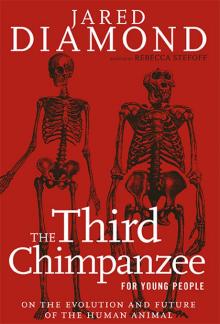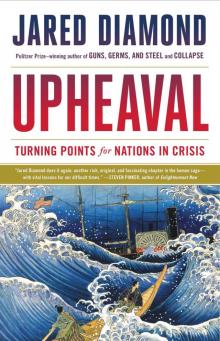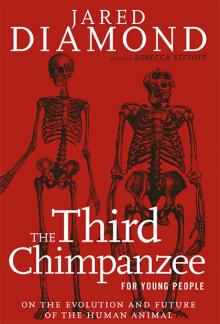- Home
- Jared Diamond
The Rise and Fall of the Third Chimpanzee Page 4
The Rise and Fall of the Third Chimpanzee Read online
Page 4
*
Do the new results about our genetic distance from chimps have any broader implications, besides technical questions of taxonomic names? Probably the most important implications concern how we think about the place of humans and apes in the universe. Names are not just technical details but express and create attitudes. (To convince yourself, try greeting your spouse this evening either as ‘my darling’ or as ‘you swine’, using the same expression and tone of voice.) The new results do not specify how we should think about humans and apes, but, just as did Darwin’s On the Origin of Species, they will probably influence how we do think, and it will probably take us many years to readjust our attitudes. I shall mention just one example of a controversial area that might be affected: our use of apes.
At present we make a fundamental distinction between animals (including apes) and humans, and this distinction guides our ethical code and actions. For instance, as I noted at the start of this chapter, it is considered acceptable to exhibit caged apes in zoos, but it is not acceptable to do the same with humans. I wonder how the public will feel when the identifying label on the chimp cage in the zoo reads ‘Homo troglodytes’. Yet if it were not for the sympathetic interest in apes that many people gain at zoos, there might be much less public financial support for conservationists’ efforts to protect apes in the wild.
I also noted earlier that it is considered acceptable to subject apes, but not humans, without their consent to lethal experiments for purposes of medical research. The motive for doing so is precisely because apes are so similar to us genetically. They can be infected with many of the same diseases as we can, and their bodies respond similarly to the disease organisms. Thus, experiments on apes offer a far better way to devise improved medical treatments for humans than would experiments on any other animals.
This ethical choice poses an even more difficult problem than does caging apes in zoos. After all, we regularly cage millions of human criminals under worse conditions than zoo apes, but there is no socially accepted human analogue of medical research on animals, even though lethal experiments on humans would provide medical scientists with far more valuable information than do lethal experiments on chimps. Yet the human experiments performed by Nazi concentration camp physicians are widely viewed as one of the most abominable of all the Nazis’ abominations. Why is it all right to perform such experiments on chimps?
Somewhere along the scale from bacteria to humans, we have to decide where killing becomes murder, and where eating becomes cannibalism. Most people draw those lines between humans and all other species. However, quite a few people are vegetarians, unwilling to eat any animal (yet willing to eat plants). An increasingly vocal minority, belonging to the animal rights movement, objects to medical experiments on animals – or at least on certain animals. That movement is especially indignant at research on cats and dogs and primates, less concerned about mice, and generally silent about insects and bacteria.
If our ethical code makes a purely arbitrary distinction between humans and all other species, then we have a code based on naked selfishness devoid of any higher principle. If our code instead makes distinctions based on our superior intelligence, social relationships, and capacity for feeling pain, then it becomes difficult to defend an all-or-nothing code that draws a line between all humans and all animals. Instead, different ethical constraints should apply to research on different species. Perhaps it is just our naked selfishness, re-emerging in a new disguise, that would advocate granting special rights to those animal species genetically closest to us. But an objective case, based on the considerations I have just mentioned (intelligence, social relationships, etc.), can be made that chimps and gorillas qualify for preferred ethical consideration over insects and bacteria. If there is any animal species currently used in medical research for which a total ban on medical experimentation can be justified, that species is surely the chimpanzee.
The ethical dilemma posed by animal experiments is compounded for chimps by the fact that they are endangered as a species. In this case, medical research not only kills individuals but threatens to kill the species itself. That is not to say that demands for research have been the sole threat to wild chimp populations – habitat destruction and capture for zoos have also been major threats – but it is enough that research demands have been a significant threat. The ethical dilemma is further compounded by other considerations: that on the average several wild chimps are killed in the process of capturing one (often a young animal with its mother) and delivering it to a medical research laboratory; that medical scientists have played little role in the struggle to protect wild chimp populations, despite their obvious self-interest in doing so; and that chimps used for research are often caged under cruel conditions. The first chimp that I saw being used for medical research had been injected with a slow-acting lethal virus and was being kept alone, for the several years until it died, in a small, empty, indoor cage at the US National Institutes of Health.
Breeding chimps in captivity for research use avoids objections based on depleting wild chimp populations, but that still does not get around the basic dilemma, any more than enslaving children of US-born blacks after abolition of the African slave trade made black slavery in the nineteenth-century US acceptable. Why is it all right to experiment on Homo troglodytes, but not on Homo sapiens? Conversely, how should we explain to parents, whose children are at risk of dying from diseases now being studied in captive chimps, that their children are less important than chimps? Ultimately, we the public, not just scientists, will have to make these terrible choices. All that is certain is that our view of man and apes will determine our decision.
Finally, changes in our attitudes about apes may be crucial in determining whether apes will survive at all in the wild. At present, their populations are threatened especially by destruction of their rainforest habitats in Africa and Asia, and by legal and illegal capture and killing. If present trends continue, the mountain gorilla, orangutan, pileated gibbon, Kloss’s gibbon, and possibly some other apes as well will exist only in zoos by the time that this year’s crop of human babies enters college. It is not enough for us to preach to the governments of Uganda, Zaire, and Indonesia about their moral obligation to protect their wild apes. These are impoverished countries, and national parks are expensive to create and maintain. If we as the third chimpanzee decide that the other two chimpanzees are worth saving, those of us in the richer countries will have to bear most of the expense. From the point of view of the apes themselves, the most important effect of what we have recently learned about the Tale of Three Chimps will be on how we feel about footing that bill.
TWO
THE GREAT LEAP FORWARD
What happened at that magic moment in evolution around 40,000 years ago, when we suddenly became human?
*
AS WE SAW in Chapter One, our lineage diverged from that of apes millions of years ago. For most of the time since then, we have remained little more than glorified chimpanzees in the ways we have made our living. As recently as 40,000 years ago, Western Europe was still occupied by Neanderthals, primitive beings for whom art and progress scarcely existed. Then there was an abrupt change, as anatomically modern people appeared in Europe, bringing with them art, musical instruments, lamps, trade, and progress. Within a short time, the Neanderthals were gone.
That Great Leap Forward in Europe was probably the result of a similar leap that had occurred over the course of the preceding few tens of thousands of years in the Near East and Africa. Even a few dozen millenia, though, is a trivial fraction (less than one per cent) of our millions of years of history separate from that of the apes. Insofar as there was any single point in time when we could be said to have become human, it was at the time of that leap. Only a few more dozen millenia were needed for us to domesticate animals, develop agriculture and metallurgy, and invent writing. It was then but a short further step to those monuments of civilization that distinguish humans from animals acro
ss what used to seem an unbridgeable gulf – monuments such as the ‘Mona Lisa’ and the Eroica Symphony, the Eiffel Tower and Sputnik, Dachau’s ovens and the bombing of Dresden.
This chapter will confront the questions posed by our abrupt rise to humanity. What made it possible, and why was it so sudden? What held back the Neanderthals, and what was their fate? Did Neanderthals and modern peoples ever meet, and if so, how did they behave towards each other?
Understanding the Great Leap Forward is not easy, and writing about it is not easy either. The immediate evidence comes from technical details of preserved bones and stone tools. Archaeologists’ reports are full of terms obscure to the rest of us, such as ‘transverse occipital torus’, ‘receding zygomatic arches’, and ‘Châtelperronian backed knives’. What we really want to understand – the way of life and the humanity of our various ancestors – is not directly preserved but only inferred from those technical details of bones and tools. Much of the evidence is missing, and archaeologists often disagree over the meaning of such evidence as has survived. Since the books and articles listed on pages 334–5 will slake the interest of readers curious to learn more about receding zygomatic arches, I shall emphasize instead the inferences from bones and tools.
*
Our ancestors were confined to Africa for millions of years, where, as we have already discussed, they diverged from the ancestors of chimps and gorillas between about six and ten million years ago. For comparison, life originated on Earth several billion years ago, and the dinosaurs became extinct around sixty-five million years ago. (Science-fiction films that depict cavemen fleeing from dinosaurs are just that, science fiction.) Initially, our ancestors would have been classified as merely another species of ape, but a sequence of three changes launched us in the direction of modern humans.
The first of these changes had occurred by around four million years ago, when the structure of fossilized limb bones shows that our ancestors were habitually walking upright on the two hindlimbs. In contrast, gorillas and chimps walk upright only occasionally, and usually proceed on all fours. The upright posture freed our ancestors’ forelimbs to do other things, among which tool-making proved the most important.
The second change occurred around three million years ago, when our lineage split into at least two distinct species. Recall that members of two animal species living in the same area must fill different ecological roles and do not normally interbreed with each other. For example, coyotes and wolves are obviously closely related and (until wolves were exterminated in most of the US) lived in many of the same areas of North America. However, wolves are larger, mainly hunt big mammals like deer and moose, and often live in large packs, whereas coyotes are smaller, mainly hunt small mammals like rabbits and mice, and usually live in pairs or small groups. Similarly, Europe’s wildcat and lynx are closely related and overlap widely in range but differ ecologically and do not interbreed.
Every human population living today has interbred with every other human population with which it has had extensive contact. Ecological differences among existing humans are entirely a product of childhood education: it is not the case that some of us are born with sharp teeth and equipped to hunt deer, while others are born with grinding teeth, gather berries, and do not marry the deerhunters. Therefore all modern humans belong to the same species.
On perhaps two occasions in the past, however, the human lineage split into separate species, as distinct as wolves and coyotes. The most recent such occasion, which I shall describe later, may have been at the time of the Great Leap Forward. The earlier occasion was around three million years ago, when our lineage split into two: a man-ape with a robust skull and very big cheek teeth, assumed to eat coarse plant food, and often referred to as Australopithecus robustus (meaning ‘the robust southern ape’); and a man-ape with a more lightly built skull and smaller teeth, assumed to have an omnivorous diet, and known as Australopithecus africanus (‘the southern ape of Africa’). The latter man-ape evolved into a larger-brained form termed Homo habilis (‘man the handyman’). However, fossil bones often attributed to male and female Homo habilis differ so much in skull size and tooth size that they may actually imply another fork in our lineage yielding two distinct habilis-like species: Homo habilis himself, and a mysterious ‘Third Man’. Thus, two million years ago there were at least two, and possibly three, proto-human species.
The third and last of the big changes that began to make our ancestors more human and less ape-like was the regular use of stone tools. This is a human hallmark with clear animal precedents: woodpecker finches, Egyptian vultures, and sea otters are among the other animal species that evolved independently to employ tools in capturing or processing food, though none of these species is as heavily dependent on implements as we are now. Common chimpanzees also use tools, occasionally of stone, but not in numbers sufficient to litter the landscape. But by around two-and-a-half million years ago, very crude stone tools appear in numbers in areas of East Africa occupied by the proto-humans. Since there were two or three proto-human species, who made the tools? Probably the light-skulled species, since both it and the tools persisted and evolved.
With only one human species surviving today but two or three a few million years ago, it is clear that one or two species must have become extinct. Who was our ancestor; which species ended up instead as a discard in the rubbish-heap of evolution; and when did this shakedown occur? The winner was the light-skulled Homo habilis, who went on to increase in brain size and body size. By around 1,700,000 years ago the differences were sufficient that anthropologists give our lineage a new name, Homo erectus, meaning ‘the man that walks upright’. (Homo erectus fossils were discovered before all the earlier fossils I have been discussing, so anthropologists did not realize that Homo erectus was not the first proto-human to walk upright.) The robust man-ape disappeared around 1,200,000 years ago, and the ‘Third Man’ (if he ever existed) must have disappeared by then also. As for why Homo erectus survived and the robust man-ape didn’t, we can only speculate. A plausible guess is that the robust man-ape could no longer compete, since Homo erectus ate both meat and plant food, and since tools and a larger brain made Homo erectus more efficient at getting even the plant food on which his robust sibling depended. It is also possible that Homo erectus gave his sibling a direct push into oblivion, by killing him for meat.
THE HUMAN FAMILY TREE
Several branches of our family tree have become extinct, including those belonging to the robust australopithecines, Neanderthals, and possibly a poorly understood ‘Third Man’ and an Asian population contemporary with Neanderthals. Some descendants of Homo habilis survived to evolve into modern humans. To recognize by different names the changes in fossils representing this line, they are somewhat arbitrarily divided into Homo habilis, then Homo erectus appearing about 1.7 million years ago, and Homo sapiens appearing about 500,000 years ago. A. stands for the genus name of Australopithecus, H. for Homo.
All the developments that I have been discussing so far were played out within the continent of Africa, to which our closest living relatives (the chimps and gorilla) are still confined. The shakedown had left Homo erectus as the sole proto-human on the African stage. Around one million years ago Homo erectus expanded his horizons. His stone tools and bones show that he reached the Near East, then the Far East (where he is represented by the famous fossils known as Peking Man and Java Man) and Europe. He continued to evolve in our direction by an increase in brain size and in skull roundness. By around 500,000 years ago, some of our ancestors looked sufficiently like us, and different enough from earlier Homo erectus, to be classified as our own species (Homo sapiens, meaning ‘the wise man’), though they still had thicker skulls and brow ridges than we do today.
Readers unfamiliar with details of our evolution might be forgiven for assuming that the appearance of Homo sapiens constituted the Great Leap Forward. Was our meteoric ascent to sapiens status half-a-million years ago the brilliant climax of E
arth’s history, when art and sophisticated technology finally burst upon our previously dull planet? Not at all: the appearance of Homo sapiens was a non-event. Cave paintings, houses, and bows and arrows still lay hundreds of thousands of years off in the future. Stone tools continued to be the crude ones that Homo erectus had been making for nearly a million years. The extra brain size of those early Homo sapiens had no dramatic effect on our way of life. That whole long tenure of Homo erectus and early Homo sapiens outside Africa was a period of infinitesimally slow cultural change. In fact, the sole candidate for a major advance was possibly the control of fire, of which caves occupied by Peking Man provide one of the earliest indications in the form of ash, charcoal, and burnt bones. Even that advance – if those cave fires really were man-lit rather than natural – would belong to Homo erectus, not Homo sapiens.
Thus, the emergence of Homo sapiens illustrates the paradox discussed in Chapter One: that our rise to humanity was not directly proportional to the changes in our genes. Early Homo sapiens had progressed much further in anatomy than in cultural attainments along the road up from chimpanzeehood. Some crucial ingredients still had to be added before the Third Chimpanzee could conceive of painting the Sistine Chapel.

 Why Is Sex Fun?: The Evolution of Human Sexuality
Why Is Sex Fun?: The Evolution of Human Sexuality Guns, Germs, and Steel: The Fates of Human Societies
Guns, Germs, and Steel: The Fates of Human Societies Collapse: How Societies Choose to Fail or Succeed
Collapse: How Societies Choose to Fail or Succeed The Third Chimpanzee: The Evolution and Future of the Human Animal
The Third Chimpanzee: The Evolution and Future of the Human Animal The World Until Yesterday: What Can We Learn From Traditional Societies?
The World Until Yesterday: What Can We Learn From Traditional Societies? The Rise and Fall of the Third Chimpanzee
The Rise and Fall of the Third Chimpanzee Upheaval: Turning Points for Nations in Crisis
Upheaval: Turning Points for Nations in Crisis Guns, Germs, and Steel
Guns, Germs, and Steel The Third Chimpanzee for Young People
The Third Chimpanzee for Young People Why Is Sex Fun?
Why Is Sex Fun?